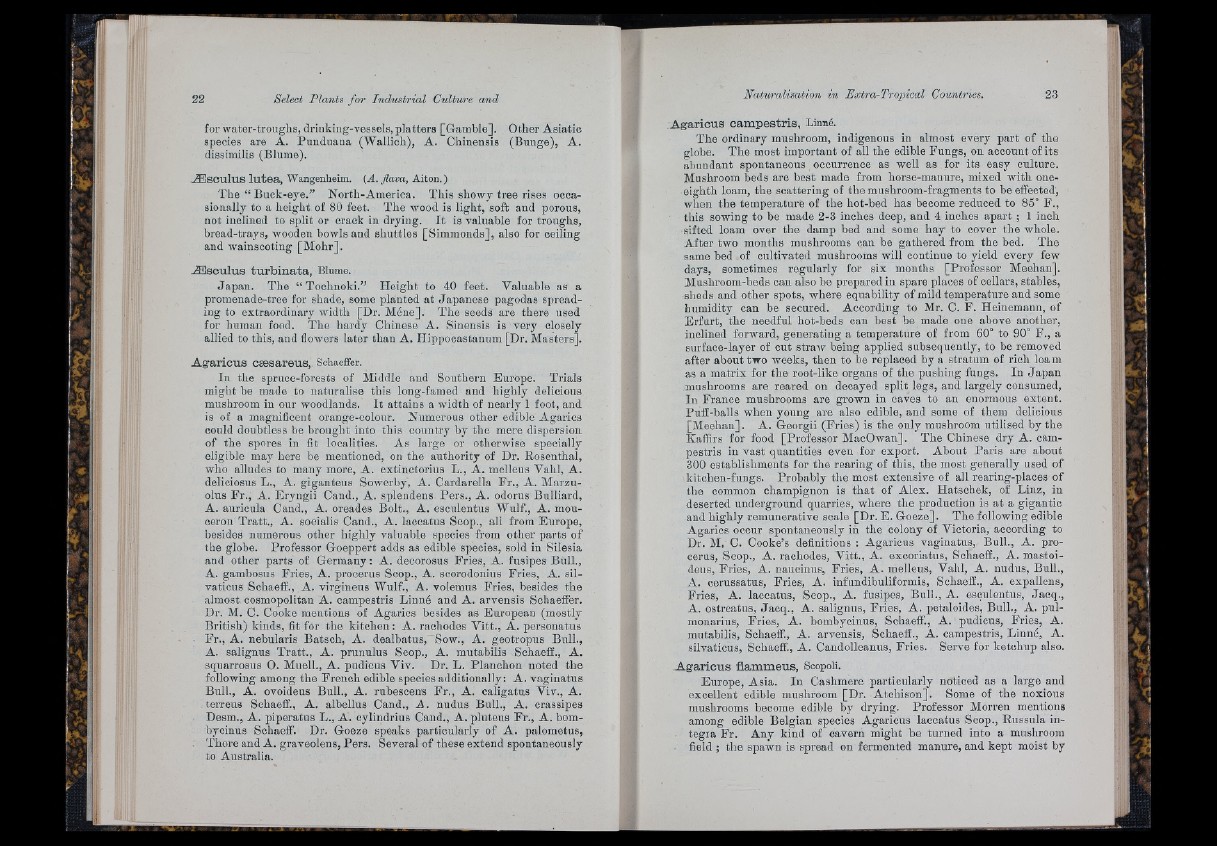
for water-troughs, driuking-vessels, platters [Gamble]. Other Asiatic
species are A. Puuduaua (Wallich), A. Chinensis (Bunge), A.
dissimilis (Blume).
Æ s c u lu s lú te a , Wangenheim. [A. flava, Aitón.)
The “ Buck-eye.” North-America. This showy tree rises occasionally
to a height of 80 feet. The wood is light, soft and porous,
not inclined to split or crack in drying. I t is valuable for troughs,
bread-trays, wooden bowls and shuttles [Simmonds], also for ceiling
and wainscoting [Mohr].
Æ s c u lu s tu r b iu a ta , Blume.
Japan. The “ Toohnoki.” Height to 40 feet. Valuable as a
promenade-tree for shade, some planted at Japanese pagodas spreading
to extraordinary width [Dr. Mène]. The seeds are there used
for human food. The hardy Chinese A. Sinensis is very closely
allied to this, aud flowers later than A. Hippocastanum [Dr. Masters].
A g a ric u s cæ s a re u s , Schaeffer.
In the spruce-forests of Middle and Southern Europe. Trials
might be made to naturalise this long-famed and highly delicious
mushroom in our woodlands. I t attains a width of nearly 1 foot, and
is of a magnificent orange-colour. Numerous other edible Agarics
could doubtless be brought into this country by the mere dispersion
of the spores in fit localities. As large or otherwise specially
eligible may here be mentioned, on the authority of Dr. Rosenthal,
who alludes to many more, A. extinctorius L., A. melleus Vahl, A.
delioiosus L., A. giganteus Sowerby, A. Cardarella Fr., A. Marzu-
olus F r., A. Eryngii Cand., A. splendens Pers., A. odorus Bulliard,
A. auricula Cand., A. oreades Bolt., A. esculentus Wulf., A. mou-
cerou Tratt., A. socialis Cand., A. laccatus Scop., all from Europe,
besides numerous other highly valuable species from other parts of
the globe. Professor Goeppert adds as edible species, sold in Silesia
and other parts of Germany: A. deeorosus Fries, A. fusipes Bull.,
A. gambosus Fries, A. procerus Scop., A. scorodonius Fries, A. sil-
vaticus SchaefE., A. virgineus Wulf., A. volemus Fries, besides the
almost cosmopolitan A. campestris Linné and A. arvensis Schaeffer.
Dr. M. 0 . Cooke mentions of Agarics besides as European (mostly
British) kinds, fit for the kitchen : A. rachodes Vitt., A. personatus
Er., A. nebularis Batsch, A. dealbatus, Sow., A. geotropus Bull.,
A. salignus Tratt., A. prunulus Scop., A. mutabilis SchaefE., A.
squarrosus O. Muell., A. pudicus Viv. Dr. L. Planchón noted the
following among the French edible species additionally: A. vagiuatns
Bull., A. ovoideus Bull., A. rnbesoenB F r., A. caligatus Viv., A.
terreas Schaeff., A. albellus Cand., A. nudus Bull., A. crassipes
Desm., A. piperatus L., A. cylindrius Cand., A. pluteus Fr., A. bom-
bycinus Schaeff. Dr. Goeze speaks particularly of A. palometus,
Thore and A. graveolens, Pers. Several of these extend spontaneously
to Australia.
A g a ric u s c am p e s tr is , Linné.
The ordinary mushroom, indigenous in almost every part of the
globe. The most important of all the edible Fungs, on account of its
abundant spontaneous occurrence as well as for its easy culture.
Mushroom beds are best made from horse-manuro, mixed with one-
eighth loam, the scattering of the mushroom-fragments to he effected,
when the temperature of the hot-bed has become reduced to 85° P.,
this sowing to be made 2-3 inches deep, and 4 inches apart ; 1 inch
sifted loam over the damp bed and some hay to cover the whole.
After two months mushrooms can be gathered from the bed. The
same bed of cultivated mushrooms will continue to yield every few
days, sometimes regularly for six months [Professor Meehan].
Mushroom-heds can also be prepared in spare places of cellars, stables,
sheds and other spots, where equability of mild temperature and some
humidity can be secured. According to Mr. C. F. Heinemann, of
Erfurt, the needful hot-beds can best be made one above another,
inclined forward, generating a temperature of from 60° to 90° F., a
surface-layer of cut stra^v being applied subsequently, to be removed
after about two weeks, then to be replaced by a stratum of rich loam
as a matrix for the root-like organs of the pushing fungs. In Jap an
mushrooms are reared on decayed split logs, and largely consumed,
111 France mushrooms are grown in oaves to an enormous extent.
PufE-balls when young are also edible, and some of them delicious
[Meehan]. A. Georgi! (Fries) is the only mushroom utilised by the
Kaffirs for food [Professor MacOwan], The Chinese dry A. campestris
in vast quantities even for export. About Paris are about
300 establishments for the rearing of this, the most generally used of
kitohen-fungs. Probably the most extensive of all rearing-places of
the common champignon is th a t of Alex. Hatschek, of Linz, in
deserted underground quarries, where the production is a t a gigantic
and highly remunerative scale [Dr. E. Goeze]. The following edible
Agarics occur spontaneously in the colony of Victoria, according to
Dr. M, C. Cooke’s definitions : Agaricus vaginatus, Bull., A. procerus,
Scop., A. rachodes, Vitt., A. excoriatus, Schaeff., A. mastoi-
deus. Fries, A. naucinus. Fries, A. melleus, Vahl, A. nudus. Bull.,
A. cerussatus, Fries, A. infundibuliformis, Schaeff., A. expallens.
Fries, A. laccatus, Scop., A. fusipes. Bull., A. esculentus, Jacq.,
A. ostreatus, Jacq., A. salignus, Fries, A. petaloides, Bull., A. pul-
monarius. Fries, A. hombycinus, Schaeff., A. pudicus. Fries, A.
mutabilis, Schaeff., A. arvensis, Schaeff., A. campestris, Linné, A.
silvaticus, Schaeff., A. Candolleanus, Fries. Serve for ketchup also.
A g a r ic u s flam m e u s, Soopoli.
Europe, Asia. In Cashmere particularly noticed as a large and
excellent edible mushroom [Dr. Atchison]. Some of the noxious
mushrooms become edible by drying. Professor Morren mentions
among edible Belgian species Agaricus laccatus Scop., Russula integra
F r. Any kind of cavern might be turned into a mushroom
field ; the spawn is spread on fermented manure, and kept moist by